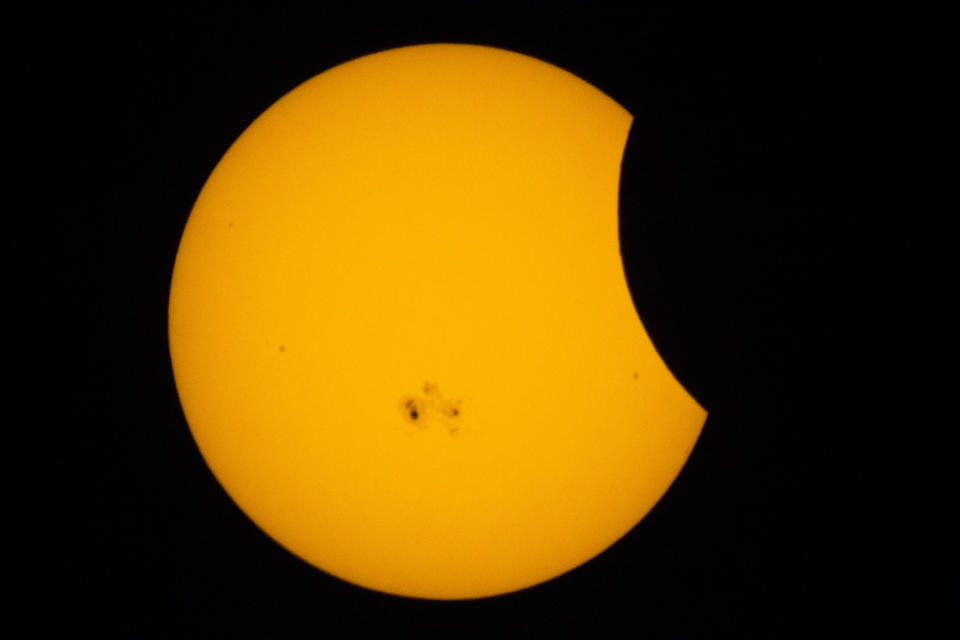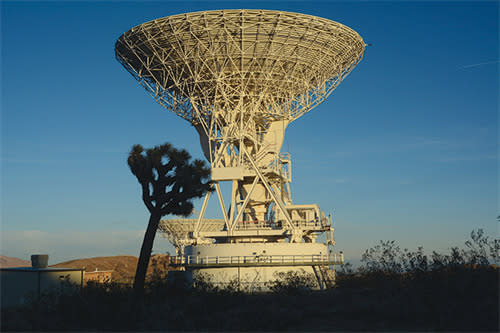NASA's plan to point a massive telescope at America's two upcoming solar eclipses

During the upcoming annular solar eclipse on Oct. 14 a 112-foot (34-meter) retired NASA radio telescope will be pointed at the sun to study what happens when sunspots are covered by the moon.
Part of the Solar Patrol citizen science program, it's a dry run for an experiment that will peak on April 8 next year during a total solar eclipse in the U.S.
Solar Patrol will study radio emission from the sun's inner corona, but exactly how and why is a story about radio telescopes, the sun's currently heightened activity and the incredible gift from nature of two solar eclipses in the same place within six months.
The NASA-funded project will use the Goldstone Apple Valley Radio Telescope (GAVRT) in California's Mojave Desert, which used to be part of NASA's Deep Space Network until it was retired over a decade ago. It's now regularly used by students to study black holes, quasars and planets — operating the telescope remotely and collecting the data — but it's also used to make maps of the sun at radio wavelengths. Twice in the coming six months, GAVRT will be pointed at the sun in an effort to tease out sunspot data that can't otherwise be obtained. Here's how it's going to work.
Related: Don't panic if you see balloons hovering during America's two upcoming solar eclipses
What the radio telescope will see
Astronomers divide the sky into degrees, but each one is divided into 60 equal segments called arc-minutes. "The sun is 30 arc-minutes across, so at any given time our antenna can look at the radiation coming from within only a portion of the sun," Thangasamy Velusamy, a scientist at NASA's Jet Propulsion Laboratory, told Space.com. Valusamy is working with educators at the Lewis Center for Education Research in Southern California on the Solar Patrol citizen science program. That means GAVRT can only 'see' about a fifth of the sun at any one time. "So what we can do best is to study the sunspots," Velusamy continued.
Sunspots are disturbances in the sun's magnetic field that can be as big as a planet and are visible as dark spots on its surface. Solar Patrol shouldn't have any problem finding them on the days of the eclipse. After all, they're a daily sight right now as the sun waxes towards solar maximum, the height of the 11-year (or so) solar cycle. "I'm sure the sun will be very active," said Velusamy. "We will have plenty to choose from."
Don't expect any incredible images — this is radio astronomy, the study of the cosmos in radio wavelengths. "Ours will not be a picture show," said Velusamy. "We'll look at the sun at gigahertz wavelengths — radio emission — so we cannot make pretty or instant pictures," he said. It is possible to image the sun in radio wavelengths, but it takes about 30 minutes, he added.
What the radio telescope will study

Solar Patrol will actually study "active regions" — the magnetically complex regions that form over sunspots in the sun's inner corona — as the moon moves over them.
"Radio frequencies don't look at the surface of the sun — the photosphere — the radio emission depends on the frequency you're looking at," said Velusamy. "We make maps at four different frequencies from 3-14 gigahertz, which means we can probe heights of 2,000 to 15,000 kilometers above the surface of the sun." That's crucial because it allows measurements of the magnetic field in the layers of the sun above the sunspots. "
A lot of space missions measure the magnetic field far away from the sun, but to connect it to what is happening in the sun we need these intermediate measurements," said Velusamy.
The difference an eclipse makes

Sunspots can be studied using a radio telescope at any time. Why do so during an eclipse? An eclipse reveals details on the sun a radio telescope can't otherwise detect. As it moves across a sunspot, the moon will block different portions of it at different times, allowing scientists to distinguish light signals coming from one portion versus another. "As the moon moves across a sunspot during the eclipse the power collected by the antenna will decrease," said Velusamy. How much it decreases depends on how bright the active region is, but the students will get two sets of data — one when the sunspot disappears behind the moon and the other when it reappears. "We'll be able to deconstruct the sunspots in very high angular resolution detail," said Velusamy.
Exactly where the telescope will be pointed will depend on where the sunspots are on the days of the eclipses, but if there are any — and it's highly likely there will be — GAVRT will detect subtle changes to the radio emissions from active regions. This same technique was first used during the last annular solar eclipse in the US in May 2012, when 83% of the sun was blocked by the moon as seen from Apple Valley.
Why April's eclipse is more important
For eclipse-chasers, totality — when the moon blocks all of the sun and twilight descends — is the big prize. That's not the case for a radio telescope.
Although GAVRT will be pointed at the sun during both solar eclipses coming up in North America, on neither occasion will the radio telescope see the best of either, with no 'ring of fire' on Oct. 14, 2023, nor totality on April 8, 2024. In fact, in October GAVRT will see 77% of the sun eclipsed by the moon while in April it won't quite reach 50%. That's largely irrelevant — the success depends on whether there are sunspots on the surface of the sun and whether the geometry means they're eclipsed by the limb of the moon. "The size of the eclipse doesn't really matter to us because we are looking at only localized regions within the sun," said Velusamy.
However, there are reasons why April's eclipse will be much easier for GAVRT to study than October's. "The sun will be very low on the horizon early in the morning on October 14, which will be very challenging," said Velusamy. At the beginning of the eclipse, the sun and moon will be just 14 degrees up in the southeast. "Our antenna can go down to 8 degrees, but it's not the best conditions for making observations." In April the eclipse begins a couple of hours later when the sun will be much higher up in the southeast — about 44 degrees.
It's for that reason that October's eclipse is something of a testbed for April's. October is also a time when the weather can be more challenging, though there's an upside to radio astronomy that all eclipse-chasers will be jealous of. "At least we don't have to think about clouds," said Velusamy. "Only optical astronomers have to worry about that."

